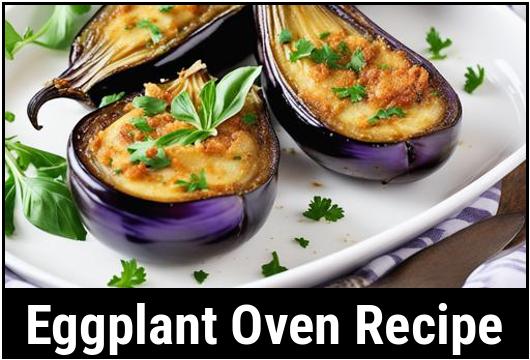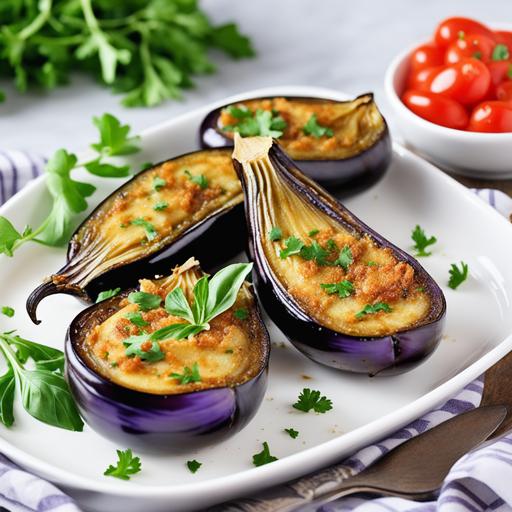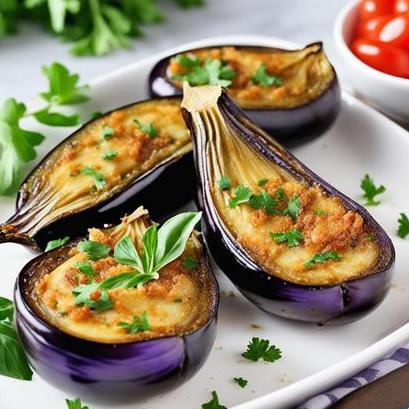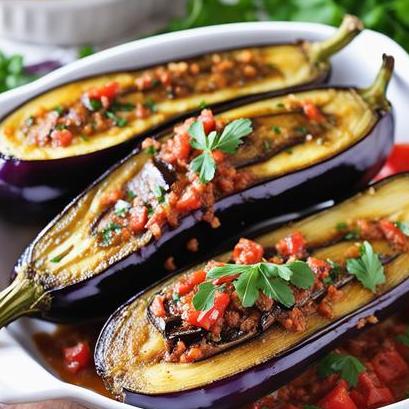
The Ultimate Guide To Eggplant Oven Recipes
Are you looking to prepare a delicious and healthy dish? Look no further than eggplant! This versatile vegetable is a culinary delight, with a rich flavor and a variety of cooking methods. In this comprehensive guide, we will explore the wonderful world of eggplant oven recipes. From understanding the food science behind this extraordinary vegetable to learning various culinary details, cleaning, preparation, tips, and even checking doneness, we’ve got you covered. So let’s dive in and discover the secrets to creating the perfect eggplant dish!
Understanding Eggplant
Eggplant, also known as aubergine, belongs to the nightshade family and is native to India. It has a glossy, deep purple skin and a creamy flesh that turns soft and buttery when cooked. Besides its distinct flavor, eggplant is a valuable source of dietary fiber, vitamins, and minerals, making it a fantastic addition to any meal.
Selection and Cleaning
Choosing the right eggplant is crucial for a successful recipe. Look for a firm and heavy eggplant with a shiny skin, free from bruises or blemishes. Remember, the color of the skin may vary depending on the variety, but it should always look vibrant and fresh.
Once you’ve selected your eggplant, follow these steps to prepare it for cooking:
-
Wash the Eggplant: Rinse the eggplant under cool running water to remove any dirt or residue.
-
Trim the Ends: Cut off the stem end and the narrow tip of the eggplant.
-
Peel or Not to Peel: While most recipes call for peeled eggplant, the decision to peel or not is based on personal preference. Eggplant skin can be slightly bitter, so if you prefer a milder taste, peel it using a vegetable peeler.
Cleaning your eggplant thoroughly ensures a clean canvas for your delicious dish.
Preparation and Culinary Details

Preparing eggplant involves a few essential steps that optimize its texture and flavor. Let’s explore each of them:
-
Salting for Bitterness: Some recipes suggest salting eggplant before cooking to reduce bitterness. This step is not always necessary for fresh and high-quality eggplants since modern varieties are less bitter. However, if you prefer, slice the eggplant, sprinkle salt over the slices, and let them sit for about 30 minutes. Rinse the salt off and pat dry before proceeding with the recipe.
-
Slicing: Depending on your recipe, slice the eggplant into rounds, planks, or cubes. Uniform slices ensure even cooking throughout.
-
Sweating for Moisture: Eggplants have a high water content that can make them soggy when cooked. To reduce moisture, sprinkle salt on both sides of the eggplant slices and let them rest on a paper towel for 15-30 minutes. Afterward, gently press the slices to remove excess moisture.
Now that we have an adequately prepared eggplant, let’s explore some useful tips to enhance your eggplant dishes.
Tips for Cooking with Eggplant

-
Oil Absorption: Eggplants tend to absorb oil like sponges. To minimize oil absorption, brush the slices with oil or use an oil sprayer instead of immersing them in oil while cooking.
-
Marinating: For extra flavor, marinate the sliced eggplant in a mixture of olive oil, garlic, herbs, and spices before cooking. Allow it to marinate for at least 30 minutes to infuse the flavors.
-
Grill or Roast: Besides oven baking, grilling or roasting the eggplant brings out a smoky flavor and enhances its natural sweetness. Put slices directly on the grill or roast them in a hot oven until tender.
-
Combining Flavors: Eggplant pairs well with a variety of ingredients. Pair it with tomatoes, basil, and mozzarella for a classic Caprese flavor. Layer it in lasagna for a hearty meal or combine it with chickpeas and spices for a flavorful vegetarian stew.
Now that you are armed with fantastic culinary techniques and tips, let’s dive into checking the doneness of your eggplant.
Doneness Checks

Determining when your eggplant is perfectly cooked requires a close eye. Here are a few indicators that your eggplant is done:
-
Texture: The flesh should be soft and creamy when pierced with a fork or knife.
-
Color: The eggplant slices should have a golden-brown color on the outside, indicating caramelization and fully cooked flesh.
-
Taste: Take a small bite to confirm that the desired tenderness and flavor are achieved.
Remember, the cooking time may vary depending on the recipe, thickness of the slices, and the type of eggplant used. Practice makes perfect, so don’t be afraid to experiment and adjust the cooking time accordingly.
Eggplant Oven Recipe

Now that you’ve mastered the art of selecting, cleaning, preparing, and checking doneness, it’s time to learn an exquisite eggplant oven recipe. Try this delectable Stuffed Eggplant dish that will impress your friends and family.
Ingredients
-
2 large eggplants
-
1 cup cooked quinoa
-
1/2 cup diced tomatoes
-
1/4 cup chopped fresh herbs (parsley, basil, oregano)
-
1/4 cup crumbled feta cheese
-
2 tablespoons olive oil
-
2 garlic cloves, minced
-
Salt and pepper to taste
Instructions
-
Preheat your oven to 375°F (190°C).
-
Slice the eggplants in half lengthwise and scoop out the flesh, leaving about a 1/2 inch border. Chop the scooped-out eggplant flesh and set aside.
-
In a pan, heat olive oil over medium heat. Add minced garlic and chopped eggplant flesh, and sauté for 5 minutes until tender.
-
In a bowl, combine the sautéed eggplant, cooked quinoa, diced tomatoes, fresh herbs, and crumbled feta cheese. Mix well.
-
Season the eggplant halves with salt and pepper. Fill each eggplant half with the stuffing mixture until evenly distributed.
-
Place the stuffed eggplants on a baking sheet and bake for approximately 30-35 minutes until the eggplant is tender and the stuffing is lightly golden.
-
Remove from the oven and let it cool for a few minutes before serving. Sprinkle with additional fresh herbs for added visual appeal.
Variations:
-
For a vegan option, omit the feta cheese and add toasted pine nuts or roasted chickpeas for added texture and protein.
-
Experiment with different herbs or spices to customize the stuffing to your liking. Cumin, paprika, and chili flakes can add a delightful twist.
-
Enhance the Mediterranean flavors by drizzling some balsamic glaze or a squeeze of lemon juice over the cooked stuffed eggplant before serving.
Congrats! You’ve mastered the art of cooking the perfect eggplant oven recipe. Now it’s time to savor the delightful flavors of your stuffed eggplant creation.
Avoiding Overcooking and Undercooking
Achieving the perfect balance between overcooking and undercooking eggplant can be challenging. Here are a few tips to help you avoid these pitfalls:
-
Undercooking: If the eggplant still feels firm or crunchy, it’s undercooked. To remedy this, return it to the oven for a few more minutes until the desired tenderness is achieved.
-
Overcooking: Overcooked eggplant becomes mushy and loses its shape. To prevent this, monitor the cooking time closely and remove the eggplant from the oven as soon as it reaches the desired texture.
Remember, cooking times can vary depending on the thickness of the slices and your oven’s temperature accuracy. Keep an eye on your eggplant to ensure the ideal outcome.
In Conclusion
Eggplant is a magnificent vegetable that provides a range of culinary possibilities. Armed with the knowledge of food science, culinary details, selection, cleaning, preparation, tips, variations, doneness checks, and a delectable recipe, you are well on your way to creating mouthwatering eggplant oven dishes. Whether you choose to stuff, roast, or grill your eggplant, the possibilities are endless. So go ahead, channel your inner chef, and let your creativity soar as you enjoy the remarkable flavors and textures of this marvelous vegetable. Happy cooking!
Sources
FAQS On Eggplant Oven Recipe
What Ingredients Are Typically Used In An Eggplant Oven Recipe?
The most common ingredients used in an eggplant oven recipe are eggplant, olive oil, salt, pepper, and tomato sauce.
How Do I Prepare The Eggplant For An Oven Recipe?
To prepare the eggplant for an oven recipe, you should first wash it thoroughly and cut off the top and bottom ends. Then, you can slice it lengthwise into 1/4 inch thick slices, and sprinkle them with salt to draw out any excess moisture.
How Long Should I Bake The Eggplant In The Oven?
The baking time for eggplant in an oven recipe can vary depending on the recipe you’re using. Generally, it takes about 25-30 minutes at 375 degrees Fahrenheit to cook the eggplant until it is tender and golden brown.
Can I Substitute Other Vegetables For Eggplant In The Oven Recipe?
Yes, you can easily substitute other vegetables for eggplant in an oven recipe. Zucchini, yellow squash, and bell peppers are great options that can be prepared in a similar way to eggplant.
What Are Some Serving Suggestions For Eggplant Oven Recipe?
Eggplant oven recipe can be served as a main dish or a side dish. You can serve it with pasta, rice, or quinoa to make a complete meal, or alongside grilled meats or fish. It can also be topped with parmesan cheese or fresh herbs like basil, parsley, or cilantro.



